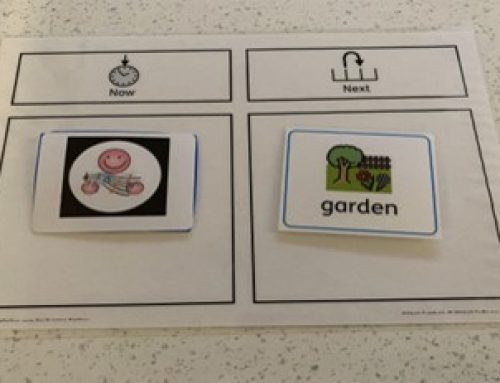How does my Receiver know that it is time for TACPAC?
In this post we will look at how you can let your TACPAC Receiver know when it is time for TACPAC, using visual, verbal, auditory, tactile and location cues.
The importance of consistency for your TACPAC Receiver
One of the main reasons TACPAC is such an effective sensory communication intervention is because of its consistency.
“This is not restrictive consistency…but a solid base on which to build authentic , exciting…practice”. (Dix 2017)
TACPAC is designed to be repetitive, “we like what we know”. Therefore establishing familiar, consistent routines for the beginning and ending of TACPAC sessions is very important for your Receivers.
Ideally, TACPAC would be scheduled for the same time, in the same place and with the same Giver and Receiver partnership, for every session. The routines described here are crucial in enabling your Receiver to cope with any changes. The preparation outlined below can enable Receivers to request TACPAC as and when they recognise they need it to meet their needs.
Tell them it’s TACPAC time: visual cues
If TACPAC is deemed an important intervention for any one of your clientele, then it needs to be given status within a provision. Whether that be on a timetable, daily schedule or programme of activities. Denote it’s occurrence using the TACPAC symbol on a visual timetable or Now and Next. This is available to download from the TACPAC website at: https://tacpac.co.uk/wp-content/uploads/2022/11/Symbol-1.pdf. Draw your Receivers attention to it and remove when the TACPAC session has finished.
You can colour photocopy the object pictures, from the Set instruction sheet. Velcro them on to a visual strip to provide an even more detailed schedule for your Receiver.
• Instruction sheets can be downloaded from the TACPAC website: https://tacpac.co.uk/. Scroll down to the bottom of the Set page to find them
• The Makaton sign for TACPAC is touch and music.
Tell them it’s TACPAC time: verbal cues
All Givers should keep their language as consistent as possible, before, during and at the end of TACPAC sessions. For example, the script for verbally indicating that it’s time for TACPAC could be “Now TACPAC”, whilst indicating and manipulating the TACPAC symbol. If “Now TACPAC” is your chosen script, ensure that everyone carrying out TACPAC uses it consistently and is not tempted to alter the script.
Remember: Givers may think that the repetition is mundane, but for your Receivers it is vital.
Tell them it’s TACPAC time: auditory musical cues
You could decide to use one of the pieces of TACPAC music as a musical cue. If you do, ensure that everyone carrying out TACPAC in your organisation uses the same piece of music. Consistency, such as this, is especially important in settings where Receivers are transitioning over many years, such as all-age schools.
You might want to sing your auditory cue, e.g. “we’re all going to TACPAC” sung to the tune of the conga. Whatever you decide, keep it consistent and maintained.
A musical instrument can also be used, to provide an auditory cue. Make sure this is only used for transition to TACPAC exclusively.
Tell them it’s TACPAC time: tactile cues and objects of reference
“Objects of reference are tangible, multi-sensory objects used to represent a person, activity or event. Over time a person can learn that the object stands for something. Objects of reference are used to help a person understand what is happening in their environment” (Kent Community Health NHS Foundation Trust).
Choose one of the TACPAC objects, e.g. the colourful plastic scourer (Set 1). An object that is easily carried and can be attached to your objects of reference boards is best. Make sure everyone is using the same object. Ones that are easily replaced, should they be lost, are ideal.
Make sure that each Receiver has their own Set of objects for the Set they are accessing. Their Set can be kept in a bag or small box which you can use as the object of reference for TACPAC.
Tell them it’s TACPAC time: location markers
You will be very lucky if you have a designated space just for TACPAC. Using location markers offer a good, consistent way in which to alter the environment, and so communicate to your Receivers that it is time for TACPAC. This might be drawing down the blinds, sitting on carpet tiles or inside PE hoops or on TACPAC-designated bean bags. Furniture might be rearranged or Receivers sit in the same place every TACPAC session.
Download the TACPAC “Do Not Disturb” sign as another indicator that is it time for TACPAC and to ensure your sessions are not disturbed https://TACPAC.co.uk/wp-content/uploads/2021/09/Do-Not-Disturb.pdf.
How does my Receiver know when TACPAC has finished?
Remember, we end every activity with a deep-pressure full stop. Keep your language consistent, e.g., “spatula has finished”. Augment with sign language, if relevant to your Receiver.
When the whole TACPAC session has finished, indicate this in whatever consistent, multi-sensory and communicative way your setting has agreed.
What if my Receiver needs TACPAC on an emergency needs basis?
There are TACPAC Receivers who need TACPAC as and when, in order to help with regulation. By teaching the routines as described here, your Receiver can learn to request TACPAC when they need to. Obviously, Receivers with verbal language skills can ask. Scaffolding sessions, as outlined in this blogpost, is always useful when levels of cognition, and/or receptive and expressive language skills are denuded. If you have TACPAC Receivers who can independently request TACPAC, ensure this can be facilitated and their request met.
Summary
- Make sure all TACPAC Givers maintain consistent practice.
- Incorporate your Receiver’s own communication system into TACPAC, e.g. signing, PECs, Talkbox etc.
- Work with families and carers to develop consistency between your setting and home using the suggestions in this blogpost.
References:
Duhigg C (2012) The Power Of Habit: Why We Do What We Do in Life and Business. New York: Random House.
Dix P (2017) When the Adult Changes Everything Changes. Wales: Independent Thinking Press.
Share your story!
Let us know if you have found this post useful. We’d love to hear how you have started your TACPAC year and if you have any top tips to add.
Email us to share your ideas, photos and videos info@tacpac.co.uk.
Find out more!
Access the TACPAC website regularly for updates and to hear about all the exciting TACPAC developments, events and experiences: https://tacpac.co.uk/.
Direct new staff and parents/carers to the TACPAC website if they have any questions. They might want to sign up for TACPAC training: https://tacpac.co.uk/tacpac-online-training/.
Read more about tucking in to a sensory diet
This is all about routines rather than food! Find out more about what we mean here: https://yourkidstable.com/sensory-diet-template/.




















